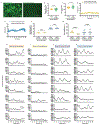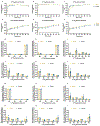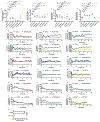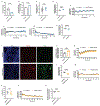Metabolic regulation of species-specific developmental rates
- PMID: 36599986
- PMCID: PMC9944513
- DOI: 10.1038/s41586-022-05574-4
Metabolic regulation of species-specific developmental rates
Erratum in
-
Author Correction: Metabolic regulation of species-specific developmental rates.Nature. 2023 Apr;616(7956):E4. doi: 10.1038/s41586-023-05924-w. Nature. 2023. PMID: 36949206 No abstract available.
Abstract
Animals display substantial inter-species variation in the rate of embryonic development despite a broad conservation of the overall sequence of developmental events. Differences in biochemical reaction rates, including the rates of protein production and degradation, are thought to be responsible for species-specific rates of development1-3. However, the cause of differential biochemical reaction rates between species remains unknown. Here, using pluripotent stem cells, we have established an in vitro system that recapitulates the twofold difference in developmental rate between mouse and human embryos. This system provides a quantitative measure of developmental speed as revealed by the period of the segmentation clock, a molecular oscillator associated with the rhythmic production of vertebral precursors. Using this system, we show that mass-specific metabolic rates scale with the developmental rate and are therefore higher in mouse cells than in human cells. Reducing these metabolic rates by inhibiting the electron transport chain slowed down the segmentation clock by impairing the cellular NAD+/NADH redox balance and, further downstream, lowering the global rate of protein synthesis. Conversely, increasing the NAD+/NADH ratio in human cells by overexpression of the Lactobacillus brevis NADH oxidase LbNOX increased the translation rate and accelerated the segmentation clock. These findings represent a starting point for the manipulation of developmental rate, with multiple translational applications including accelerating the differentiation of human pluripotent stem cells for disease modelling and cell-based therapies.
© 2023. The Author(s), under exclusive licence to Springer Nature Limited.
Conflict of interest statement
Figures














Comment in
-
Metabolism dictates the pace of development across species.Nature. 2023 Jan;613(7944):439-440. doi: 10.1038/d41586-022-04483-w. Nature. 2023. PMID: 36599994 No abstract available.
-
Mitochondria: A "pacemaker" for species-specific development.Mol Cell. 2023 Mar 16;83(6):824-826. doi: 10.1016/j.molcel.2023.02.025. Mol Cell. 2023. PMID: 36931252
References
-
- Matsuda M, et al. , Species-specific segmentation clock periods are due to differential biochemical reaction speeds. Science, 2020. 369(6510): p. 1450. - PubMed
-
- Stearns SC, The Evolution of Life History Traits: A Critique of the Theory and a Review of the Data. Annual Review of Ecology and Systematics, 1977. 8(1): p. 145–171.
Materials and Methods References
-
- Chal J, et al. , Differentiation of pluripotent stem cells to muscle fiber to model Duchenne muscular dystrophy. Nat Biotechnol, 2015. 33(9): p. 962–9. - PubMed
-
- Chal J, et al. , Recapitulating early development of mouse musculoskeletal precursors of the paraxial mesoderm in vitro. Development, 2018. 145(6). - PubMed
-
- Chal J, et al. , Generation of human muscle fibers and satellite-like cells from human pluripotent stem cells in vitro. Nat Protoc, 2016. 11(10): p. 1833–50. - PubMed
-
- Tomishima M, Neural induction – Dual SMAD inhibition, in StemBook. 2008, Harvard Stem Cell Institute. Copyright: © 2012 Mark Tomishima.: Cambridge (MA). - PubMed
-
- Oceguera-Yanez F, et al. , Engineering the AAVS1 locus for consistent and scalable transgene expression in human iPSCs and their differentiated derivatives. Methods, 2016. 101: p. 43–55. - PubMed
Publication types
MeSH terms
Substances
Grants and funding
LinkOut - more resources
Full Text Sources
Research Materials

